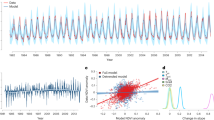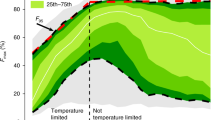Abstract
Climate change is often characterized in terms of climate sensitivity, the globally averaged temperature rise associated with a doubling of the atmospheric CO2 (equivalent) concentration. In this study, we develop and apply two new ecological sensitivity metrics, analogs of climate sensitivity, to investigate the potential degree of plant community changes over the next three centuries. We use ten climate simulations from the Intergovernmental Panel on Climate Change Fourth Assessment Report, with climate sensitivities from 2–4°C. The concept of climate sensitivity depends upon the continuous nature of the temperature field across the Earth’s surface. For this research, the bridge between climate change and biospheric change predictions is provided by the Equilibrium Vegetation Ecology model (EVE), which simulates a continuous description of the Earth’s terrestrial plant communities as a function of climate. The ecosensitivity metrics applied to the results of EVE simulations at the end of the twenty-first century result in 49% of the Earth’s land surface area undergoing plant community changes and 37% of the world’s terrestrial ecosystems undergoing biome-scale changes. EVE is an equilibrium model, and, although rates of ecological change are not addressed, the resultant ecological sensitivity projections provide an estimate of the degree of species turnover that must occur for ecosystems to be in equilibrium with local climates. Regardless of equilibrium timescales, the new metrics highlight the Earth’s degree of ecological sensitivity while identifying ecological “hotspots” in the terrestrial biosphere’s response to projected climate changes over the next three centuries.
Article PDF
Similar content being viewed by others
Avoid common mistakes on your manuscript.
References
Bergengren JC, Thompson SL, Pollard D, DeConto RM (2001) Modeling global climate–vegetation interactions in a doubled CO2 world. Climatic Change 50(1–2):31–75
Box EO (1996) Plant functional types and climate at the global scale. J Veg Sci 7(3):309–320
DeConto RM, Bergengren JC, Hay WW (1998) Modeling Late Cretaceous climate and vegetation. Zentralblatt für Geologie und Paläontologie, Teil I 11(12):1433–1444
DeConto RM et al (1999a) Late Cretaceous climate, vegetation, and ocean interactions. In: Huber B, MacLeod KG, Wing SL (eds) Warm climates in earth history. Cambridge University Press, Cambridge, pp 275–297
DeConto RM, Hay WW, Thompson SL, Bergengren JC (1999b) Late Cretaceous climate and vegetation interactions: the cold continental interior paradox. In: Barrera E, Johnson C (eds) The evolution of cretaceous ocean/climate systems, vol 332. Geological Society of America Special Paper, pp 391–406
Delcourt HR, Delcourt PA, Webb III T (1983) Dynamic plant ecology: the spectrum of vegetation change in time and space. Quat Sci Rev 1:153–175
Feddema J et al (2005) A comparison of a GCM response to historical anthropogenic land cover change and model sensitivity to uncertainty in present-day land cover representations. Clim Dyn 25(6):581–609
Hannah L, Lovejoy T, Schneider S (2005) Biodiversity and climate change in context. In: Lovejoy T, Hannah L (eds) Climate change and biodiversity, pp 3–14
Hansen J, Sato M, Ruedy R, Lacis A, Oinas V (2000) Global warming in the twenty-first century: an alternative scenario. Proc Natl Acad Sci 97(18):10304–10306
IPCC (2007) Climate change 2007: the physical science basis. IPCC Secretariat, Geneva
Lovejoy T, Hannah L (2005) Climate change and biodiversity. Yale University Press, New Haven
McCarty J (2001) Ecological consequences of recent climate change. Conserv Biol 15(2):320–331
Pollard D, Bergengren JC, Stillwell-Soller LM, Felzer B, Thompson SL (1998) Climate simulations for 10000 and 6000 years BP using the GENESIS global climate model. Palaeoclimat Data Model 2(2):183–218
Sala OE et al (2000) Global biodiversity scenarios for the year 2100. Science 287(5459):1770–4
Scheffer M, Carpenter S, Foley JA, Folke C, Walker B (2001) Catastrophic shifts in ecosystems. Nature 413(6856):591–596
Schneider SH (2001) What is ‘dangerous’ climate change? Nature 411:17–19
Schneider SH (2004) The discovery of global warming. Nature 427(6971):197–198
Senior CA, Mitchell JFB (2000) Time-dependence of climate sensitivity. Geophys Res Lett 27(17):2685–2688
Thomas CD et al (2004) Extinction risk from climate change. Nature 427(6970):145–148
Washington WM, Meehl GA (1989) Climate sensitivity due to increased CO2: experiments with a coupled atmosphere and ocean general circulation model. Clim Dyn 4(1):1–38
Author information
Authors and Affiliations
Corresponding author
Additional information
This paper is dedicated to my great friend and mentor Steve Schneider. —J. C. Bergengren
Rights and permissions
Open Access This is an open access article distributed under the terms of the Creative Commons Attribution Noncommercial License (https://creativecommons.org/licenses/by-nc/2.0), which permits any noncommercial use, distribution, and reproduction in any medium, provided the original author(s) and source are credited.
About this article
Cite this article
Bergengren, J.C., Waliser, D.E. & Yung, Y.L. Ecological sensitivity: a biospheric view of climate change. Climatic Change 107, 433–457 (2011). https://doi.org/10.1007/s10584-011-0065-1
Received:
Accepted:
Published:
Issue Date:
DOI: https://doi.org/10.1007/s10584-011-0065-1




